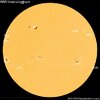SOLAR CYCLE ACTIVITY REPORT JANUARY 11/2023
The region that erupted almost simultaneously with the X1.9 flare was assigned the number 13186 and debuted a few hours ago with an X1.06 class flare at 22:47 UTC on January 10. Prior to this X-class flare, solar activity was moderate with some M-class flares:
● M1 from AR3184 at 02:16 UTC produced a Minor R1 Radio blackout over Oceania
● M2.6 from AR3181 at 02:41 UTC produced a Minor R1 Radio blackout over Oceania
● M1 from AR3184 at 11:08 UTC produced a Minor R1 Radio blackout over Indian Ocean
● M1.35 from AR3186 at 17:28 UTC produced a Minor R1 Radio blackout over South America
● M1.25 from AR3184 at 17:48 UTC produced a Minor R1 Radio blackout over South America
● X1.06 from AR3186 at 22:47 UTC produced a Strong R3 Radio blackout over South west Pacific Ocean
● M2.47 from AR3186 at 01:00 UTC on January 11 produced a Minor R1 Radio blackout over Oceania
● M5.67 from AR3184 at 01:30 UTC on January 11 produced a Moderate R2 Radio blackout over Oceania

There are currently 8 numbered sunspot regions on the solar disk: AR3180, AR3181, AR3182, AR3183, AR3184, AR3185 and new regions AR3186 and AR3187
AR3186 located on the northeast (N25E65) is a group of five sunspots with size 100HM and beta-delta magnetic field. NOAA forecasts 85% chance for C flares
Preliminary data for AR3187: it is located on the northeast (N13E18) is a group of two sunspots with size 10HM and magnetic field. It poses no threat for strong solar flares.
The total number of sunspots has increased to 175 (115 of these are grouped into 8 active regions) NOAA forecasts for the next 24h: 99% chance for C flares, 70% chance for M flares and 35% chance for X flares.

● Auroral Activity
The geomagnetic field has been at quiet levels for the past 24 hours. Solar wind speed reached a peak of 418 km/s at 20:27 UTC on January 10 Maximum planetary index: Kp 3
Aurora Oval

● Current Conditions at 02:46 UTC on January 11
▪︎Geospace quiet
▪︎Geomagnetic conditions now Kp 2
▪︎Solar wind speed record: 409.7 km/sec
▪︎density: 6.55 protons/cm3
▪︎Neutron Counts today: +2.4 Elevated
▪︎X-ray Solar Flare: M5 01:30 UTC
▪︎Sunspot number: 175 (SN 142 Jan 10)
SpaceWeather.com
SpaceWeatherlive..com
The region that erupted almost simultaneously with the X1.9 flare was assigned the number 13186 and debuted a few hours ago with an X1.06 class flare at 22:47 UTC on January 10. Prior to this X-class flare, solar activity was moderate with some M-class flares:
● M1 from AR3184 at 02:16 UTC produced a Minor R1 Radio blackout over Oceania
● M2.6 from AR3181 at 02:41 UTC produced a Minor R1 Radio blackout over Oceania
● M1 from AR3184 at 11:08 UTC produced a Minor R1 Radio blackout over Indian Ocean
● M1.35 from AR3186 at 17:28 UTC produced a Minor R1 Radio blackout over South America
● M1.25 from AR3184 at 17:48 UTC produced a Minor R1 Radio blackout over South America
● X1.06 from AR3186 at 22:47 UTC produced a Strong R3 Radio blackout over South west Pacific Ocean
● M2.47 from AR3186 at 01:00 UTC on January 11 produced a Minor R1 Radio blackout over Oceania
● M5.67 from AR3184 at 01:30 UTC on January 11 produced a Moderate R2 Radio blackout over Oceania
What magnetic connection is there on that side of the sun that is provoking violent reactions?CME THIS TIME: Yesterday's X1.9-class solar flare did not hurl a CME toward Earth. Although it was intense, the blast was too brief to lift a CME out of the sun's atmosphere. Next time may be different. There are now three large sunspots (AR3181, 82 and 84) with unstable 'delta-class' magnetic fields capable of strong explosions. SpaceWeather.com
SOLAR FLARE CAUSES RARE 'MAGNETIC CROCHET': The X-flare of Jan. 9th did something rare. It jerked Earth's magnetic field. Here is a composite of magnetometer recordings from Boulder, Colorado; Honolulu, Hawaii; and Fredericksburg, Virginia:
The "jerk" is circled in yellow. It began around 1846 UT, and was detected by many magnetic observatories across the dayside of Earth.
The phenomenon is called a 'magnetic crochet.' Radiation from the flare ionized the top of Earth's atmosphere and caused currents to flow 60 km to 100 km above Earth's surface. These currents, in turn, briefly altered Earth's magnetic field. Everything returned to normal a few minutes later. SpaceWeather.com
There are currently 8 numbered sunspot regions on the solar disk: AR3180, AR3181, AR3182, AR3183, AR3184, AR3185 and new regions AR3186 and AR3187
AR3186 located on the northeast (N25E65) is a group of five sunspots with size 100HM and beta-delta magnetic field. NOAA forecasts 85% chance for C flares
Preliminary data for AR3187: it is located on the northeast (N13E18) is a group of two sunspots with size 10HM and magnetic field. It poses no threat for strong solar flares.
The total number of sunspots has increased to 175 (115 of these are grouped into 8 active regions) NOAA forecasts for the next 24h: 99% chance for C flares, 70% chance for M flares and 35% chance for X flares.
● Auroral Activity
The geomagnetic field has been at quiet levels for the past 24 hours. Solar wind speed reached a peak of 418 km/s at 20:27 UTC on January 10 Maximum planetary index: Kp 3
Aurora Oval
● Current Conditions at 02:46 UTC on January 11
▪︎Geospace quiet
▪︎Geomagnetic conditions now Kp 2
▪︎Solar wind speed record: 409.7 km/sec
▪︎density: 6.55 protons/cm3
▪︎Neutron Counts today: +2.4 Elevated
▪︎X-ray Solar Flare: M5 01:30 UTC
▪︎Sunspot number: 175 (SN 142 Jan 10)
SpaceWeather.com
SpaceWeatherlive..com

